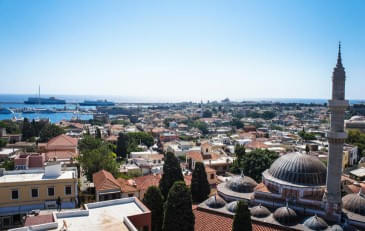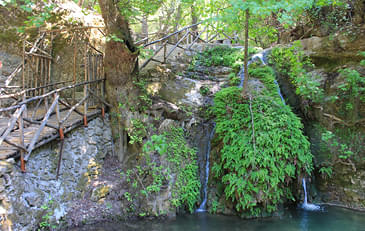Tourist Attractions
On the Island
Hiking
Rhodes offers nature lovers and hikers numerous opportunities for exploring the island on foot. Visitors can hike through a diverse natural environment in search of ancient sites, castles and medieval chapels scattered across Rhodes. Hiking trails throughout the island offer appropriate levels for everyone.
RHODES TOWN
Visiting the old town of Rhodes, which was designated as a world heritage city by UNESCO in 1988, is a must for anyone holidaying on Rhodes. You will discover vestiges of different historical cultures. One of the oldest attractions is the ruins of the former Temple of Aphrodite. The ancient Acropolis can be found on Monte Smith around 40 minutes to the west of Rhodes Town. The climb is well worth it, simply for the amazing view. Sturdy shoes are a must, however.
Acropolis and Lindos
With its attractive panorama and whitewashed houses, Lindos is known as the “Pearl of Rhodes”. The powerful, imposing Acropolis stands high above the village, giving a breathtaking view of the picturesque village with the white beach and the turquoise sea beyond. Lindos is one of the most important ancient sites and a must for every visitor. Tours generally start at the “Platia Elefterias” (Freedom Square), from where you can complete the climb to the Acropolis in the “Lindos taxi”, on a donkey or on foot.
Filerimos
The Filerimos mountain, which translates as "friend of solitude", is a popular recreational area for the inhabitants of Rhodes City. The acropolis of the ancient Ialyssos once stood on it. It is worth the trip up the mountain in peace and quiet, because mighty pines, herbal scents and circuses line the path. The ruins and buildings on Filerimos mountain date back three millennia, of which the monastery from the 10th century is the best preserved. The church of Agios Georgios Chostos has precious frescoes depicting scenes from the life of Christ but also kneeling knights and the eight-pointed cross of the Knights of St. John. Immediately in front of the monastery are the remains of a small temple of Athena from the 2nd to 3rd century B.C., an early Christian basilica with a preserved baptistery and several chapels from the 15th/16th century.
Mandraki Harbour
Somehow when travelling to Rhodes Town, you always end up at Mandraki Harbour. This where the “Colossus of Rhodes” (one of the seven wonders of the world) is said to have stood in ancient times. Mandraki Harbour dates back to around 400 B.C. Translated, the name means “small sheep pen”, probably because of its shape: the harbour looks like a pair of pliers and encloses the ships like a shepherd's pen. The harbour later served as a military harbour for the Knights of St. John when they stationed their fleet there.
Today it is a mooring place for yachts, sailing boats and pleasure boats. The 400-metre long dyke with its three windmills is perfect for a stroll. Agios Nikolaos, a small 15th century fortress, stands at the end of the dyke. “Nea Agora”, the new market with its numerous cafés and restaurants, is located opposite.
Monolithos
70 km away from Rhodes Town lies Monolithos, a charming village with small, cosy tavernas. The remains of a castle built by the Knights of St. John can be found on a hill overlooking the sea around 3 km from the village. Dating from 1476, it is the southernmost castle built by the Knights of St. John on the island. The walk to the plateau is rewarded with a wonderful view. If you travel around 3 km further from Monolithos around 3 km towards the sea, you come to a medieval fortification of the same name. The Byzantine castle offers a broad panoramic view.
Prassonissi
Prassonissi is located on the southern tip of Rhodes and offers an almost untouched landscape, vast beaches and a magnificent natural environment. A sense of Greece’s mythological heritage is still very much present. There are monuments and museums to visit, and you can enjoy excellent meals in the many cosy tavernas along the coast. The area is a paradise for windsurfers and kitesurfers.
Valley of Butterflies
Petaloudes, to use the Greek name for the Valley of Butterflies, is one of the island’s most famous and most interesting attractions. From June to September, it is home to thousands of butterflies. The mainly reddish-brown butterflies with yellow stripes are known by their scientific name of Callimorpha Quadripultaria. The steep path through the valley leads through lush vegetation, past clear pools of water and rock stacks. To protect the butterflies, it's important for visitors to observe the signs.
Symi
Symi is a mountainous rocky island and is considered the most picturesque place in the Aegean. The island is easily reached by ferry. The largest church on the island, St. Mary's church, is located in the harbour area. The Museum of Antiquities in Ano Simi is well worth a visit. The “Panormitis Monastery” with large Byzantine frescos lies around 30 km from Ano Simi. Simi is a good place to spend a day, bathing in one of the wonderful coves or exploring the island on foot or by bike.

 Deutsch
Deutsch














